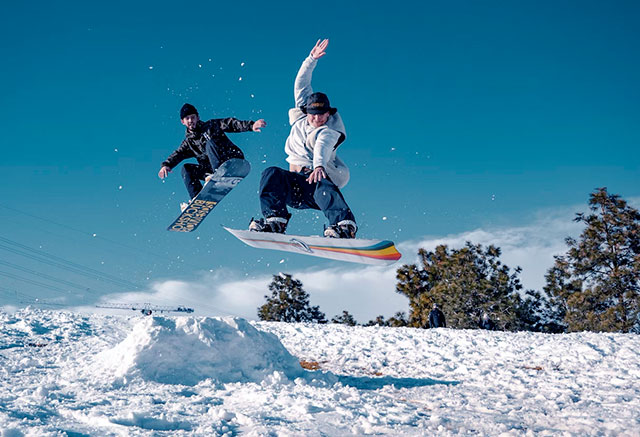Ever wondered why some sports photos pop with vitality, capturing the peak of action, while others fall flat? It's more than just serendipity. Locking down the art of sports photography blends technique with an almost prescient sense of timing.
 live action photos on the snow
live action photos on the snowThis guide is a playbook for amateur photographers aiming to snag shots that embody the vigor and fellowship inherent in sports - all without needing pro-level gear.
So whether it’s dialing in on camera settings or positioning yourself for the perfect angle, you'll garner strategies here that ensure your images not only commemorate wins and losses but truly encapsulate the spirit of athletic endeavor.
The added bonus?
Advice on curating your victories into memorable albums that resonate with every viewer's inner champion.
Crafting a Thematic Victory Lane
Your sports photography isn't merely a collection of images; it's the curation of momentous occasions. Starting with thematic photo albums allows you to orchestrate a narrative that tracks progress, highlights accomplishments, and tells stories of resilience and teamwork.
Imagine each album as its own championship saga.
To elevate this, consider creating an anniversary photo album - an annual tradition encapsulating the year's best athletic moments. This practice transforms your photography into a legacy, allowing athletes and fans alike to relive each season with fondness and anticipation for what the next will bring.
Sports Photography Tips Amateurs Should Know
1. Ace It On Camera Settings
First, address your camera settings, the backbone of dynamic sports imagery. Start with a fast shutter speed; it's crucial for freezing motion and capturing crisp action shots without blur. Think 1/500th of a second as your baseline.
Adjusting aperture and ISO is equally vital. A wider aperture (a lower f-stop number) lets in more light, yielding a focused subject against a softly blurred background.
As for ISO, balance is key - too high, and you risk grainy photos; too low, and your shot may be underexposed. Hit this sweet spot, and you're in the game.
2. The Winning Angle
Angles are not just about perspective; they're about storytelling. Elevate your game by shooting from varied vantage points - low angles can dramatize action, while high angles offer an omniscient view of the field.
Experiment with your position relative to the sun for natural light play that can emphasize the intensity or joy on athletes' faces.
Finally, keep mobile and anticipate play movement. Positioning yourself where the action will be, rather than where it is, sets you apart and brings a proactive edge to capturing those split-second triumphs that define sports photography.
3. Timing Your Shot to Perfection
Timing in sports photography is not just about snapping a photo; it's the art of foreseeing the peak moment before it unfolds. Acquaint yourself with the sport you’re capturing - its rhythms, its unexpected turns - to better predict these climaxes.
Embrace patience and stay sharply focused on the action; a burst mode can help massively, but indiscriminate shooting leads nowhere. You hunt for that decisive instant when victory is in the making.
Practiced intuition combined with technical readiness captures more than a game's image - it seizes its very essence.
4. Emotion: The Heart of the Frame
Capturing emotion is about more than a shutter click; it’s about storytelling through expressions. Eyes locked in concentration, fists clenched in triumph, or the collective euphoria of a team - these are the raw moments that resonate.
Look beyond the main event. Sideline interactions and audience reactions can offer equally compelling narratives full of heart and human spirit.
Keep your lens poised not just on the field, but also on the periphery where emotions run high, unguarded. Here lies the soul of sports photography: in every nuanced human moment worth preserving.
5. The Dance of Light and Shadow
Mastering light is akin to choreographing a dance, balancing brightness with shadow to sculpt your subject. Aim for the golden hours at dawn or dusk when light flatters most but prepare for midday challenges by softening harsh contrasts with filters or reflectors.
Mindful manipulation of light adds depth and drama, turning routine shots into masterpieces that celebrate athleticism in its best light, quite literally.
And that’s just about it! In the arena of sports photography, each shot captured is a victory in itself.
As you utilize these tips, remember that what you’re framing is more than a game - it's a series of stories waiting to be told. So grab your camera, find your angle, and let the moments unfold.
Related Pages
- Essential Equipment for Sports Photographers
- Sports photography courses
- Sports Photography: art plus more
- Sport Photography Techniques
- Our collection of sports photos
- Media at the Olympic Games
- Sports Photos


 Current Events
Current Events